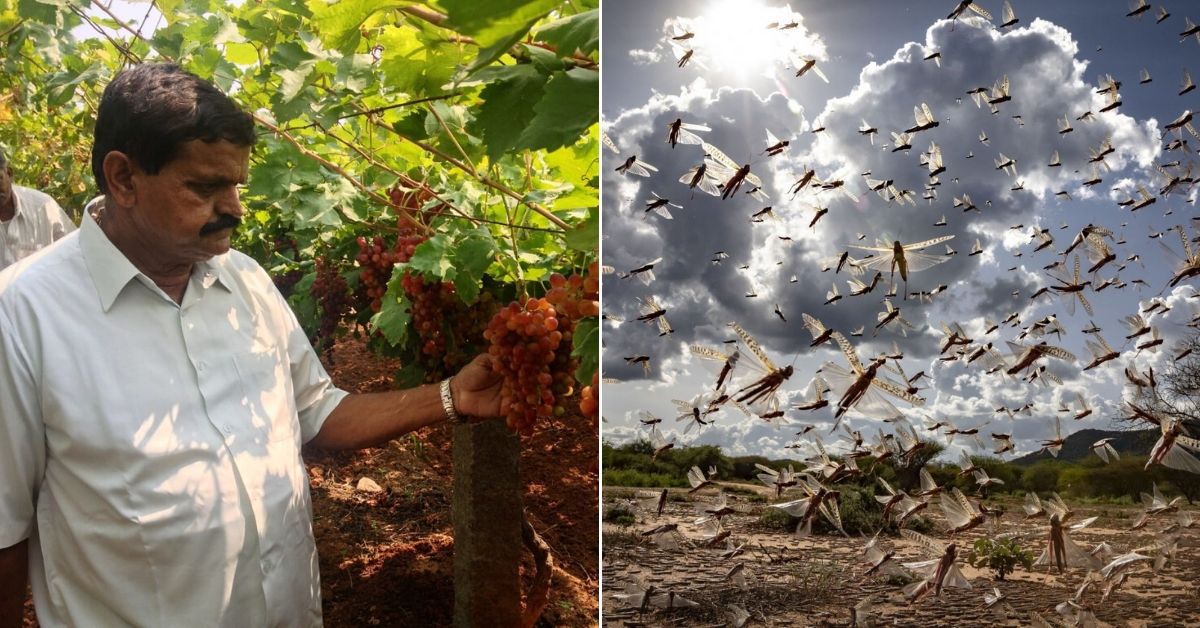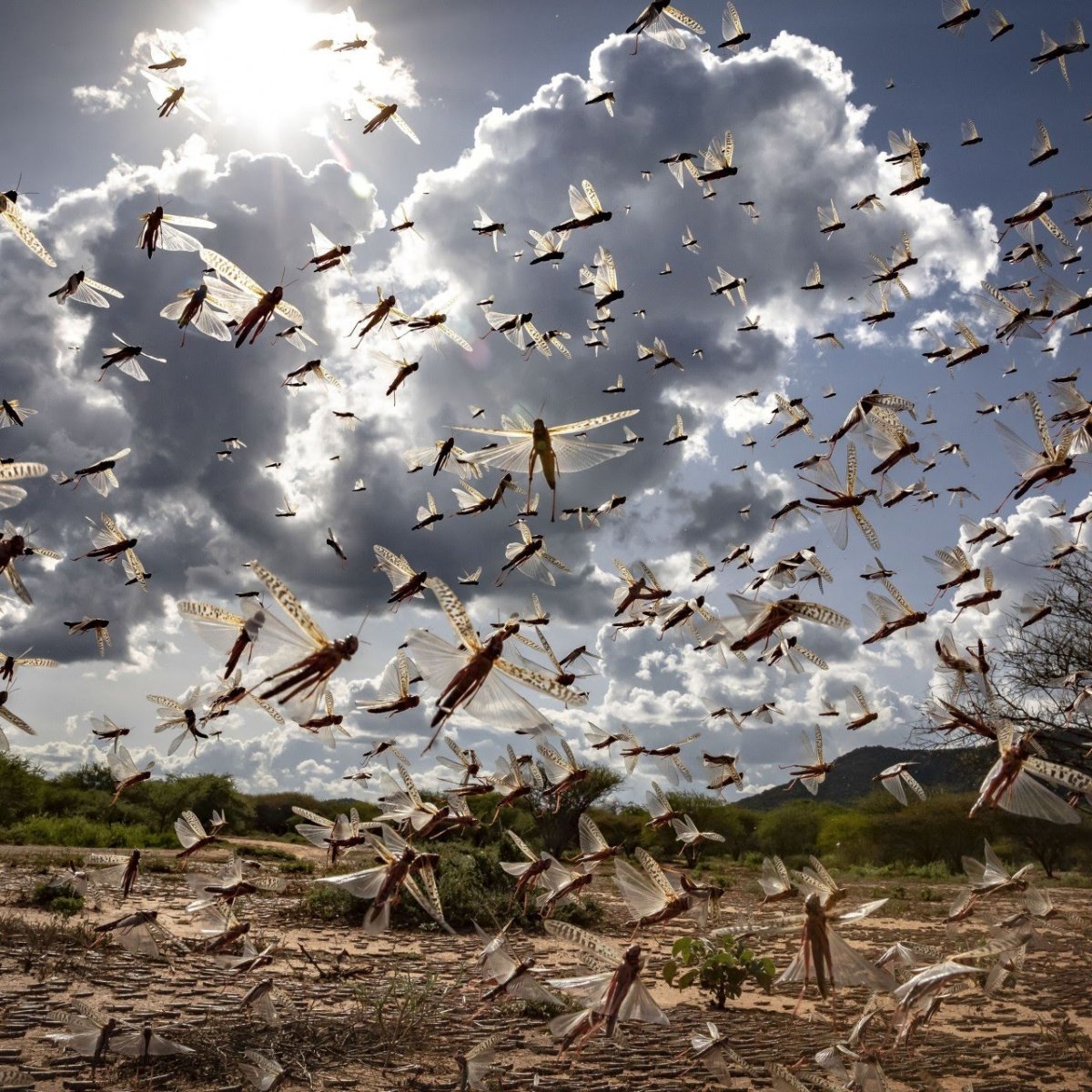69-YO Padma Shri Farmer’s Organic ‘Muddy’ Solution May Drive Locusts Away
"The neighbouring farms suffered 1-2% destruction even as they lit fires and played loud noises to drive the locusts away. On the other hand, my farm suffered absolutely no loss."

Since April 11 2020, vast swathes of land in India have been invaded by locust swarms. From Rajasthan to Madhya Pradesh and even Maharashtra, these pests have targeted vegetable and pulse crops, leaving farmers, who were already reeling from the impact of COVID-19 and the consequent lockdowns, devastated.
AM Bharia, a Plant Protection Officer from the Locust Warning Organisation spoke to The Better India about why the army of these locusts came to India and how this became one of the deadliest attacks here. You can read all about it here.
While there are different strategies being adopted to fight off the insects, one surefire way to protect the crops from destruction is to spray them with harmful pesticides. However, for Chinthala Venkat Reddy, Hyderabad-based farmer, this is unacceptable.
Back in 2004, he had developed an organic method to keep locusts and such other pests away from farms. This year, he was awarded the Padma Shri for his innovative techniques in increasing farm yield without using synthetic chemicals.
The Better India (TBI) spoke with Reddy about his “soil pesticide” technique and how it is useful to keep locusts away. What he shared was simply fascinating.
Soil: A solution to Farmers’ Woes?
Reddy was born to a farmers’ family and voluntarily discontinued his education after Class 12, to become a full-time grape farmer. In 1982, there was a drought in the region, so he started digging up wells to get more water to his field. That idea was a success and soon, the muddy water was flowing in his fields.
A few months later, he observed something peculiar—the fields had given a higher yield even though the drought-like conditions were continuing. It wasn’t long before Reddy realised that the soil from the water had nourished the vines and began to study how soil could be used to protect plants from pests and insects, and even developed a simple method for this.
The first one is to prepare soil as a nourishing agent. For that, a trench about 4 feet deep is dug and the soil below that is collected. It is mixed with castor cake, a natural nitrogen fertilizer, and dried in the sun. This soil is preserved under tarpaulin for future use and usually sprayed on crops after diluting in adequate water to get satisfactory results.
Now, coming to using soil as a pesticide.
A Padma Shri Winner Who Suggests Controlling Locust Attacks With Soil:

Reddy tells TBI, “One must understand the anatomy of insects like a locust to know what will attract them and what will repel them. Locusts do not have a liver so they cannot digest clay contents. If they don’t have anything to feed on in my field, they will avoid and deroute.”
His method is based on two simple observations: how a locust eats and where they breed. If the crops provide no substantial nourishment, why would they attack it? “Much like an army gets an intelligence report of a new area, locusts first study the potential of a farm. If they don’t see any good prospects, they move on. So, if they don’t get food, they won’t breed,” the 69-year-old farmer shares.
The Procedure To Make Soil Pesticide:

- Take 15 kg of topsoil (collected from a two inches depth from your farm) and sun dry it completely.
- Take 15 kg subsoil from a four feet depth and sun dry this separately. It is preferable to take the soil from your own field and to undertake this method in peak summer months.
- The 15 kg quantity can differ depending on the type of crop and area you have under cultivation. Since Reddy has grape farms, this quantity is sufficient for him. Make sure you maintain the 1:1 ratio.
- Once completely dry, mix these soils in 200 litres of water.
- Mix them well with a stick and then allow the mixture to settle for about 30 minutes. You will notice that the mud has settled on the bottom.
- Filter the top water with a cloth or sieve and spray or sprinkle on your crop with a machine or by hand. Do this within four hours of the mud settling. The mud can be reused as a root application for your crops.
- This spraying must be done at least once every 7 to 10 days. For vegetables, do it once every four days for best results.
- Please note that you can dry the soil in bulk, preserve it under tarpaulin and mix it with water batch-by-batch as per your need. Make sure the dried soil does not come in contact with water or moisture before you intend to use it as pesticide.
“Farmers can also spray water first and take subsoil in dry form and sprinkle or distribute like fertilizer. That will stick to the plants and also saves the sprayers from jamming,” Reddy tells Telangana Today.
A Locust-Repelling Method Admired by Farmers:

Reddy is in contact with hundreds of farmers from Maharashtra, Bihar, Gujarat, Madhya Pradesh etc. Many of them have implemented this technique, and passed it on to their friends. While he acquired a patent for these techniques in 2012, he is happy to share it with his fellow farmers for free.
“This is not my invention. It is the country’s invention. If it is helping farmers, it is helping India and for that purpose, I am happy to share it with all,” he tells TBI.
Prem Narayan is an organic farmer from Madhya Pradesh. In his 32-acre farm, he grows mung bean, wheat, chickpeas and mustard. Three years ago, he got acquainted with Reddy and since 2018, he has implemented his soil pesticide method.
“I always sprinkled soil on my crops. But that was just the topsoil. Reddy has taken it many steps ahead by getting subsoil into the equation and I can see the results. The quality of the yield is top-notch and what’s more, this year, the locust attacks showed how effective it is as a pesticide. The neighbouring farms suffered 1-2 per cent destruction even as they lit fires and played loud noises to drive the locusts away. On the other hand, my farm suffered absolutely no loss,” he tells TBI, adding that he also adds some neem oil to the mixture to make the pesticide even more effective.
If you want to connect with Reddy to understand his method in more depth, you can contact him on [email protected]
(Edited by Gayatri Mishra)
Like this story? Or have something to share? Write to us: [email protected], or connect with us on Facebook and Twitter.
If you found our stories insightful, informative, or even just enjoyable, we invite you to consider making a voluntary payment to support the work we do at The Better India. Your contribution helps us continue producing quality content that educates, inspires, and drives positive change.
Choose one of the payment options below for your contribution-
By paying for the stories you value, you directly contribute to sustaining our efforts focused on making a difference in the world. Together, let’s ensure that impactful stories continue to be told and shared, enriching lives and communities alike.
Thank you for your support. Here are some frequently asked questions you might find helpful to know why you are contributing?


This story made me
-
97
-
121
-
89
-
167











